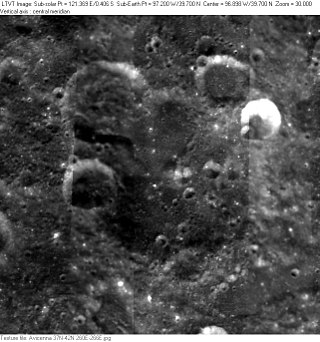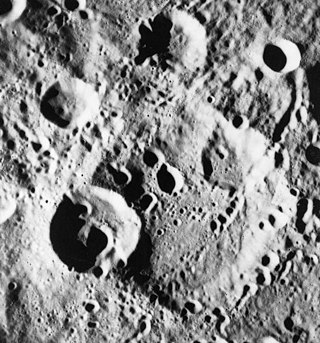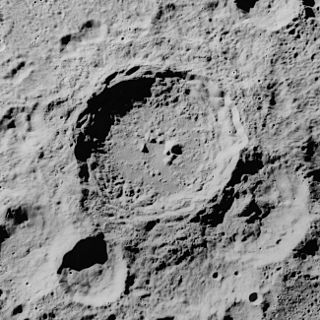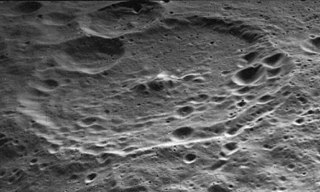
Avicenna is a lunar impact crater that lies on the far side of the Moon, just beyond the western limb on the northern rim of the Lorentz basin. It is named after the Persian polymath Avicenna. It lies to the north-northwest of the larger crater Nernst, and to the southeast of Bragg.

Fechner is a lunar impact crater that lies on the far side of the Moon's southern hemisphere, attached to the western rim of the large walled plain Planck. The eastern rim of Fechner intersects the Vallis Planck, a long, wide cleft in the surface that follows a course to the north-northwest. This valley intrudes into the southeastern rim of the crater, then continues northwards from the periphery of the northeast rim.

Biela is a lunar impact crater that is located in the rugged highlands of the southeastern Moon. It is named after Austrian astronomer Wilhelm von Biela. The crater lies to the east of Rosenberger, to the southeast of the Watt–Steinheil double crater.

Fabry is a large lunar impact crater of the form termed a walled plain. It is located on the far side of the Moon, just beyond the northeastern limb. Parts of this area are sometimes brought into view by the effects of libration, but the terrain is seen from the edge and so not much in the way of detail can be observed.

Brouwer is a large lunar impact crater that is located in the southern hemisphere on the far side of the Moon. Intruding into the western rim of Brouwer is the younger and somewhat smaller crater Langmuir. Further to the east-southeast is the larger walled plain Blackett.

Zhiritskiy is a lunar impact crater that is located on the far side of the Moon. It lies to the south of the large walled plain Fermi, and northwest of the crater Schaeberle.

Moore is an impact crater that is located on the far side of the Moon. Like much of the far side, Moore is located in a region that has been saturated by impacts. Nearby craters of note are Larmor to the south-southwest, and Parsons about the same distance to the west.

Chrétien is a lunar impact crater that is located in the southern hemisphere on the far side of the Moon from the Earth. It lies due south of the Mare Ingenii, one of the few maria on the Moon's far side. The crater lies in the midpoint between the craters Garavito to the west-southwest and Oresme to the east-northeast, both of these being somewhat smaller than Chrétien.

Coriolis is a lunar impact crater that is located on the far side of the Moon. The crater floor is bisected by the lunar equator, and it lies about three crater diameters northwest of the crater Daedalus.

Dyson is a lunar impact crater, 63 kilometers in diameter, that lies on the far side of the Moon, past the northwest limb. It is located in the northern part of the surface, to the northwest of the crater Coulomb, and east of van't Hoff.

Dove is a small lunar impact crater located in the rugged lunar highlands in the southeastern part of the Moon. It lies to the north of the prominent crater Pitiscus. The crater is named after Prussian physicist Heinrich Wilhelm Dove.

Fourier is a lunar impact crater that is located in the southwestern part of the Moon's near side, just to the southeast of the crater Vieta. To the northeast is the Mare Humorum. The rim of this crater is roughly circular, but appears oval when viewed from the Earth due to foreshortening.

Danjon is a lunar impact crater on the far side of the Moon. It lies less than a crater diameter to the east-southeast of the larger crater Langemak. To the east-northeast of Danjon is the crater Perepelkin, and due south lies the walled plain Fermi.

FitzGerald is a large lunar impact crater on the far side of the Moon. It lies to the west-southwest of the crater Cockcroft, and about two crater diameters to the northeast of Morse.

Stefan is a lunar impact crater on the far side of the Moon, just beyond the northwestern limb. Attached to the western rim is the slightly smaller crater Wegener, and close to the eastern rim is Rynin.

Szilard is a damaged lunar impact crater that lies to the east-northeast of the crater Richardson. It is named after Leó Szilárd, the scientist who theorised nuclear chain reactions and famously worked on the atomic bomb during World War II. About a half-crater-diameter to the northwest is the large walled plain Harkhebi. Between Harkhebi and Szilard is the small Giordano Bruno. The ray system from this impact forms streaks across the rim and interior of Szilard.

Nernst is a lunar impact crater that lies on the far side of the Moon, just beyond the northwestern limb. It lies across the northern part of the larger walled plain Lorentz, and intrudes slightly into the northwestern rim of the crater Röntgen.

Olcott is a relatively fresh crater on the far side of the Moon. It was named after American astronomer William Tyler Olcott. It lies to the south-southeast of the craters Seyfert and Polzunov, and to the north of Kostinskiy.

Parenago is an impact crater on the Moon's far side, behind the eastern limb. Nearly attached to the east-southeastern outer rim of Parengo is the crater Berkner. To the south-southwest lies Comrie.

Schuster is a lunar impact crater that lies along the eastern rim of the much larger walled plain Mendeleev, on the far side of the Moon. To the east of Schuster is the crater Henderson, and to the southeast lies the large Chaplygin.























